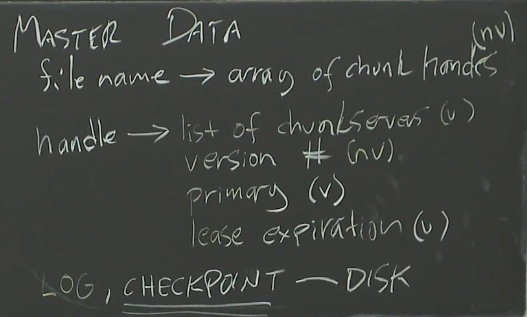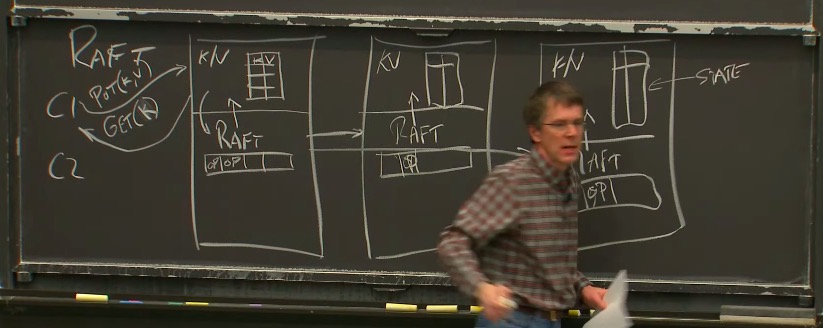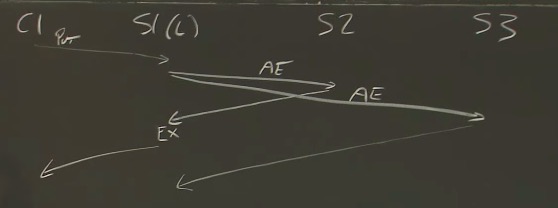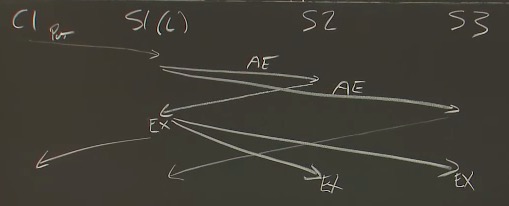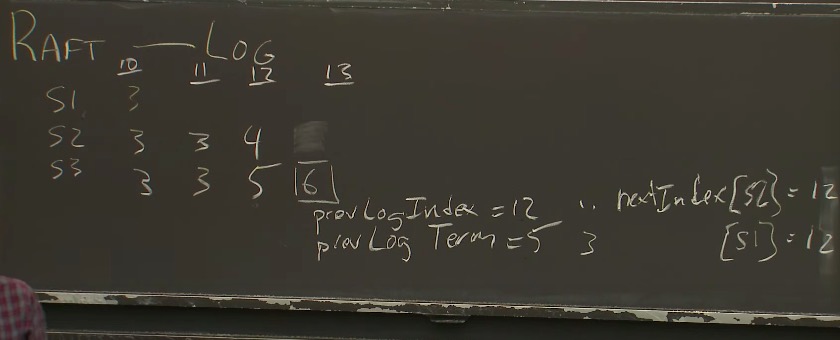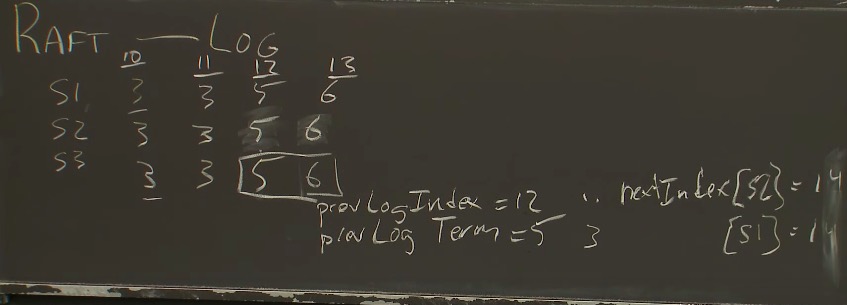本Repo记录了MIT 6.824课程相关的笔记以及收集了RAFT相关好的文章和视频
课程Lab的地址: https://pdos.csail.mit.edu/6.824/
Raft作者的论文(为什么要Raft, Paxos为什么不好)(论文里的Figure 2真的很重要): https://pdos.csail.mit.edu/6.824/papers/raft-extended.pdf
Raft作者亲自讲解Raft: https://www.youtube.com/watch?v=vYp4LYbnnW8&t=94s&ab_channel=DiegoOngaro
一个不错的Raft文章(适合新手): https://kasunindrasiri.medium.com/understanding-raft-distributed-consensus-242ec1d2f521
Raft动画在线演示(易于理解): http://thesecretlivesofdata.com/raft/
某位国内大佬的博客(里面有lab实现): https://yuerblog.cc/2020/08/13/mit-6-824-distributed-systems-%e5%ae%9e%e7%8e%b0raft-lab2a/
根据课程规定,本Repo将不会公开MIT-6.824 Lab相关的代码和解决方案,以鼓励更多的优质课程开源分享
According to the course rules and code of conduct, the Lab code and solution associated with the MIT-6.284 course will not be open sourced in order
to encourge sharing of high quality courses like this.
- 能用一台机器解决的问题,就不要用分布式
- Scalability - 2x Computers -> 2x Throughput
- Fault Tolerance:
- Availability
- Recoverability:
- NV(non-volatile storage) Storage: 断电后能恢复,但是代价昂贵,expensive to update, 应该避免使用
- Replication: identical servers 推荐
- Strong Consistency: 非常expensive, 不推荐 10ms网络延迟communication cost, 能丢失百万条指令
- Weak Consistency: 推荐
- MapReduce:
- Reduce这一块要用到网络通信,网络通信要消耗带宽,如果有10TB文件要MapReduce,则Reduce阶段要在网络中发送10TB,最后产出10TB,网络消耗非常大
- 分布式系统要用到很多的网络通信,网络这一块很重要
- MIT推荐书籍Effective Go
go run -race xxx.go可以用来进行竞争检查
ch := make(chan []string)
for urls := range ch{
update ch // 这个for可能永远都不会停止
}
S1和S2处理C1、C2请求的(时间)顺序不同,出现不同的结果,没有consistency,所以是bad design
- GFS是在一个Data center里,而不是全球都有around the world
- GFS是Big sequential access, 就是GB、TB大文件,而不是random的
- GFS是基于Master Worker的,Master DATA见下图
- version 表示最新的版本 write的时候要比较,然后在最新的版本append
以下是GFS write时的操作,左边INCREMENT V#是指Master increment, 右边如果primary returns "no" to client, 则client会继续发起这个写请求
直到成功为止,Google好像并没有提不成功的情况

- GFS没有Strong Consistency, 所以存的东西可能丢失、重复!
- 如果Pimary挂了,在Secondary选举为新的Primary后,要进行同步Sync, 因为可能有Last set operation有的做了有的没做
- GFS使用单一节点作为Master,其实是有问题的,出现Out of Memory RAM,所有东西都在内存里,加内存不够
- State transfer: Primary sends state to the secondary(Sync) e.g Send memory to the backup.
- sends memory
- Replicated State Mache: Assuming state transfer is deterministic unless there are external factors. Thus, Primary do not send state, instead , it sends
external factors to the secondary (backup).
- sends operations from client
- What state? 主从复制考虑的问题
- Primary/Backup Sync 主从同步
- Cut-over 主从转换,比如主机挂了需要提升一个新的主机
- Anomalies 外界不应该感知到主机挂了
- New replicas 备份从挂了,也需要一个新的备份
- 一般情况下是Primary收到一条指令(packet?),然后发给Backup也执行这条指令(packet),但是有一些指令是weird instructions比如获取当前时间,获得进程ID,随机数之类的, 在主和从会产生不同的结果,这种情况下从需要等主执行完后将结果告诉它
- Output Rule: Primary can not generate output(ACK) to the client until all the backups generate output to the primary.
- 一般情况下,client和Primary以及Secondary连接使用TCP协议,Primary把TCP包转给Secondary,回复ack时会把tcp Sequence number带上,所以 如果client收到两份ack(primary and secondary)通过查看Seq,会把第二个Secondary发的给drop掉
- Split Brain(脑裂)的解决:让第三方authority来确定谁是Primary, 有一个TEST-AND-SET Server,让左脑和右脑同时发送test-and-set命令给这个Server, Server先收到谁的命令就让谁set为真正的Primary.
// 在for中使用goroutine的时候,如果用到i,要用go func(x int)的形式将i传进去
// 因为for会把i的值改掉,因此当goroutine运行到这一行sendRPC(x or i)这一行时
// i会变成for更改后的值``
func main() {
var wg sync.WaitGroup
for i := 0; i < 5; i++ {
wg.Add(1)
go func(x int) {
sendRPC(x)
wg.Done()
}(i)
}
wg.Wait()
}
func sendRPC(i int) {
println(i)
}// periodic模型
var done bool
var mu sync.Mutex
func main() {
time.Sleep(1 * time.Second)
println("started")
go periodic()
time.Sleep(5 * time.Second)
mu.Lock()
done = true
mu.Unlock()
println("cancelled")
time.Sleep(3 * time.Second) // observe no output
}
func periodic() {
for {
println("tick")
time.Sleep(1 * time.Second)
mu.Lock()
if done {
// 这是个bug, 因为return前没有Unlock()!加上
mu.Unlock()
return
}
mu.Unlock()
}
}func main() {
println("started")
defer println("1")
defer println("2")
defer println("3")
defer println("4")
defer println("5")
}
// 这段代码会打印 defer小知识:按defer的顺序理解为入栈,最后出栈
started
5
4
3
2
1// 首先来看这一段代码, 这段代码为什么不行,就是因为它一直在忙等待(busy waiting),for一直尝试获取锁
// 这样会带来大量的cpu消耗,所以一定要避免忙等busy waiting
for {
mu.Lock()
if count >= || finished == 10{
break
}
mu.Unlock()
}
// do something
mu.Unlock()// 这种方法会有magic number,但是可以解决忙等的问题
for {
mu.Lock()
if count >= || finished == 10{
break
}
mu.Unlock()
time.Sleep(50 * time.Millisecond)
}// Condition broadcast wait类似于signal和wait, 区别是signal用于唤醒一个
// cond.Wait()的时候会讲这个加入到一个wait list里然后等待broadcast
// cond要绑定一个mutex
cond := sync.NewCond(&mu)
for i := 0 ...{
go func(){
vote := requestVote()
mu.Lock()
defer mu.Unlock()
if vote{
count++
}
finished++
cond.Broadcast() // broadcast一定要在Unlock()操作之前
}()
}
mu.Lock()
for count < 5 && finished != 10{ // 这里要是false的判断
cond.Wait()
}
// do something
mu.Unlock()Condition模版:
mu.Lock()
// do something that might affect the condition
cond.Broadcast()
mu.Unlock()
----
mu.Lock()
while condition == false{
cond.Wait()
}
// new condition is true, and we have the lock
// do something
mu.Unlock()// 这段代码 fatal error: all goroutines are asleep - deadlock!
// c <- true这行代码会一直block 因为没有receiver
func main() {
c := make(chan bool)
c <- true // blocks until other goroutine receives
<-c
}- you should avoid buffered channels use
make(chan bool)instead ofmake(chan bool, 5) - waitgroup.Add()一般是在go func(){}()之前,这样保证在wg.Wait()之前
MapReudce, GFS, and TEST-AND-SET Server都有一个共同点,就是都是只有一个Master节点来存储一些元数据,这样就会有**单点故障(Single point of failure)**的问题, 为了解决这个问题,就要引入多台机器来故障容错
一个不错的Raft文章: https://kasunindrasiri.medium.com/understanding-raft-distributed-consensus-242ec1d2f521
Raft动画在线演示: http://thesecretlivesofdata.com/raft/
- 第一步是要有奇数(odd)台机器,而不是偶数(even)台机器
- 用户(clients)不知道它交流的是Master还是Replica,在外界看来好像只有一台机器
- Paxos没有Leader
- 有Leader的好处是更加的efficient, 如果没有Leader,对于操作首先可能要选出temp leader,然后达成一致,这样不够efficient
- each term will have at most 1 leader(could be 0 or 1)
- 如何选Leader? 需要Leader得到大多数的yes vote在选举期间,但是在选举期间,每台server最多只能投一张yes vote, 保证了 每个term最多只能有一个leader
- 选举的时候有一个timer, 如果timer时间到了,会开启新一轮term的选举, term++
假设有三台服务器S1,S2,S3, 每台服务器有应用层(存储kv数据库), Raft协议层(存储操作log), 有两个客户端client对其访问,client可以 有put和get操作,首先client对leader的应用层发出比如说put请求,此时leader的应用层会通知Raft层,加入到操作log里,与此同时,Raft层会向其它所有的Replica节点进行通信,告知此操作,其它节点的Raft层也会通知应用层,并且对Leader的Raft层进行回应,此时Leader的Raft层会通知应用层,然后应用层对client进行回应
但事实上只要Leader收到大多数来自Replica的回应(>n/2,包括leader本身),然后leader就会执行该客户请求的操作,并且会对client进行回复,参照上图
但是此时Replica并未执行具体操作,只是将其写入raft log中,在leader对client回复的时候,也会发送通知给replica, 在这时replica才真正执行客户命令
因为用户client其实并不关心replica是否执行,只是否在leader处成功写入, 所以对replcia来说可以之后执行
对replica来说不光关心用户的命令是什么,这些命令的顺序同样重要, 并且方便reboot
在一定的时间后,不同机器上的log可能会diverge, 但是Raft会有机制强制使得log变成相同的
假设有三台机器,每一台机器的Raft log index存放了那个时期的term number, 当出现不一致的时候,比如在index 12, S2的term 记录的是4, S3记录的是5, 在index 13的时候,S3被选为了term 6的leader, 此时S3向S2和S1发送Append Entry的时候,会发送 prevLogIndex和prevLogTerm,S2发现与其不一样,于是会拒绝这个Append Entry
这时Raft Leader会有一个回溯机制,nextIndex[S2]=12, 一直往前回溯,发现在index 11的时候S2和S3是一样的,于是S2将其index 12 和13设置为与term 6 Leader S3一致的log, 同理对S1则继续回溯,发现在index 10的时候一致
- Log
- CurrentTerm
- VoteFor
